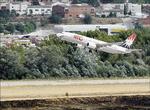
AP
A plane takes off near the site where a Spanair jet crashed on Wednesday during take-off at Madrid airport, Spain, on Friday. Spain's civil aviation chief said Friday a combination of factors probably caused the fiery plane crash in Madrid, which killed 153 people.
MADRID, Spain (AP):
SPAIN'S TOP aviation official said Friday that a glitch in an air .temperature gauge that forced a Madrid jetliner to abandon its first take-off attempt an hour before it crashed should be closely examined to see if it contributed to the accident.
In an interview with The Associated Press, Civil Aviation chief Manuel Bautista said a combination of failures - either technical, human or both - likely caused Wednesday's crash, which killed 153 people, many of them children and families on vacation. Nineteen people survived.
Aviation experts have described the air gauge problem as a relatively minor thing unlikely to have caused the crash. But Bautista would not rule out a link, saying it depends on what else was happening to the plane.
Cleared
The glitch occurred while the jet was taxiing on its first take-off attempt, causing the pilot to turn the plane around. After technicians were brought in to take a look, the gauge was essentially turned off, which is an accepted procedure, and the plane was cleared for takeoff, according to Spanair. It crashed on the second attempt at take-off.
"A problem with a temperature sensor may not matter at all, or it can be very important, depending on what other circumstances accompany it," Bautista said. "We will have to see what other issues were present.
"Clearly, the breakdown was important enough for the pilot to halt the maneuver and have it reviewed," he told the AP.
Fire
Newspapers say some eyewitnesses reported seeing fire in one of the plane's two engines shortly before it crashed, but Bautista said that - even if true - a single engine's failure alone would not have been enough to bring down a modern aircraft, which is designed to fly on one engine if necessary.
"A set of causes probably came together to cause the accident," Bautista said.
Many relatives of victims are being put up at a hotel while they wait to collect the remains of their loved ones. Javier Nunez, a Spaniard in his 40s who lost three children in the crash, complained that their bodies have been moved from a makeshift morgue to a cemetery far across town.
"What am I doing stuck here in this huge hotel when my children have been moved 30 kilometres away? I want to be with them," he said.
Maria Abongozar, the head of a Red Cross psychological team working with the victims' families, said they are anxious to get back home.
"They really want to go home so they can get on with their lives," she told reporters. "That is the way they will best deal with this situation."
An official funeral presided over by Madrid's archbishop has scheduled for September 1.
Rescuers, too, say they are exhausted and traumatised by what happened. Some told stories of heartbreaking poignancy.
Severely injured
Firefighter Francisco Martinez told of Amalia Filloy, a mother severely injured in the crash, who insisted that rescuers pull her 11-year-old daughter Maria out first.
The woman died, along with an older daughter, but Maria and her father survived.
Martinez rescued one of two little boys who survived the crash and took him to his truck to explain what was happening.
"He asked if what was happening was for real," Martinez told reporters. "He thought it was a movie, and asked where his father was and when the movie would end."
The investigation into the crash could take months.
Experts from the US National Transportation Safety Board, Boeing - which acquired airplane manufacturer McDonnell Douglas in 1997 - and engine manufacturer Pratt & Whitney, have arrived in Spain to help.
The two black boxes have been recovered. The government says the one that records technical data on the flight is badly damaged, but Bautista said he did not know how much this might hinder the investigation.
He said he has seen - but would not comment on - video footage from the airport that shows the doomed airliner trying to take off. The newspapers El Pais and ABC said it shows no engine explosion, contrary to some witness accounts.
The video is reported to show the plane using up virtually the entire runway as it tries to take off, then struggling to gain altitude. The airliner eventually crashed, skidded, burned and largely disintegrated.
Another factor investigators will be looking at is the position of survivors on the flight. El Pais reported that five of them had been sitting towards the front of the plane, including 30-year-old Spanish telecoms engineer Rafael Vidal, who had been bumped off an earlier flight because it was full.
"Flying first class is what saved him," said his mother, Pilar Rodriguez.

